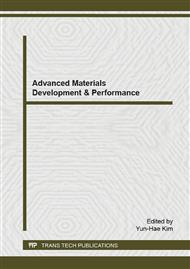p.191
p.197
p.203
p.207
p.211
p.218
p.222
p.226
p.231
Electrical and Optical Properties of ZnO:Ag Thin-Films Depend on Lamination Formation by DC Magnetron Sputtering
Abstract:
Transparent conductive oxides such as Impurity doped indium oxides, tin oxides, zinc oxide systems are widely used in the field of optoelectronics such as Photo voltaic solar cells, Flat panel displays. Recently in case of the ZnO / Ag Multilayer thin films, doping Ag films on the ZnO layer and ZnO deposited on top of it a way that has been used. However, if thin film applied to the semiconductor, because of lamination of various forms, characteristics of stacking sequence and thin film layer is a need for research. In this study, using DC magnetron sputteirng how the stacking sequence of the film and the transparent operation of various process variables, the possibility of the application to electronic devices was confirmed.
Info:
Periodical:
Pages:
211-217
Citation:
Online since:
June 2015
Authors:
Price:
Сopyright:
© 2015 Trans Tech Publications Ltd. All Rights Reserved
Share:
Citation:


